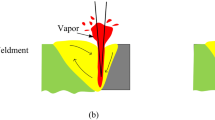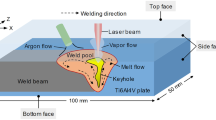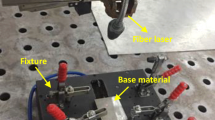Abstract
In order to get a deeper understanding of laser beam welding, a process model was developed at the Chair of Manufacturing Technology. It is based on the continuity equation, the equation of heat conduction and the Navier–Stokes equation. The model includes effects of Fresnel absorption, vapor pressure, surface tension, melting and evaporation enthalpy and energy loss due to evaporating material. This paper presents the results of a three-dimensional, transient finite volume simulation of a laser beam deep penetration welding process based on this model. The simulations show periodic keyhole oscillations and the complex fluid dynamics of the melt pool. A comparison of the evaporation rates calculated from the simulations and the experimentally observed process emissions shows good correlation. Furthermore, the simulations show pore formation at higher feed rates, the influence of a gap on the welding process and give an explanation for the welding behavior of zinc coated steel sheets.









Similar content being viewed by others
References
Ye X-H, Chen X (2002) Three-dimensional modeling of heat transfer and fluid flow in laser full-penetration welding. J Phys D Appl Phys 35:1049–1056. doi:10.1088/0022-3727/35/10/313
Ki H, Mohanty PS, Mazumder J (2001) Modelling of high-density laser–material interaction using fast level set method. J Phys D Appl Phys 34:364–372. doi:10.1088/0022-3727/34/3/320
Klein T, Vicanek M, Simon G (1996) Forced oscillations of the keyhole in penetration laser beam welding. J Phys D Appl Phys 29:322–332. doi:10.1088/0022-3727/29/2/008
Ruf A (2004) Modellierung des Perkussionsbohrens von Metallen mit kurz- und ultrakurzgepulsten Lasern, Dissertation, IFSW Stuttgart, Herbert Utz Verlag, München
Solana P, Ocana JL (1997) A mathematical model for penetration laser welding as a free-boundary problem. J Phys D Appl Phys 30:1300–1313. doi:10.1088/0022-3727/30/9/005
Geisel M (2002) Prozesskontrolle und –steuerung beim Laserstrahlschweißen mit den Methoden der nichtlinearen Dynamik, Dissertation, Chair of Manufacturing Technology, Meisenbach Verlag, Bamberg
Beyer E (1995) Schweißen mit Laser. Springer, Berlin
Dowden JM (2001) The mathematics of thermal modeling. Chapman & Hall/CRC, Boca Raton
Demtröder W (2001) Experimentalphysik 1–Mechanik und Wärme, 2nd edn. Springer, Berlin
© 2004-2008 OpenCFD Limited, http:/www.opencfd.co.uk
Hirt CW, Nichols BD (1981) Volume of fluid (VOF) method for the dynamics of free boundaries. J Comput Phys 39:201–225. doi:10.1016/0021-9991(81)90145-5
Ubbink O (1997) Numerical prediction of two fluid systems with sharp interfaces. PhD Thesis, University of London
Müller MG (2002) Prozessüberwachung beim Laserstrahlschweißen durch Auswertung der reflektierten Leistung, Dissertation, Herbert Utz Verlag, München
Stöcker H (2000) Taschenbuch der Physik, 4th edn. Verlag Harri Deutsch, Thun
Wachter A, Hoeber H (1998) Repetitorium Theoretische Physik. Springer, Berlin
Schoonderbeek A (2005) Laser drilling of metals with a XeCl excimer laser. PhD Thesis, Nederlands Centrum voor Laser Research, Print Partners Ipskamp, Enschede
Kägeler C, Albert F, Mys I, Grimm A, Urmoneit U (2007) Observation of process oscillations during high power laser welding. In: Geiger M, Otto A, Schmidt M (eds) Proceedings of the LANE 2007. Meisenbach, Bamberg, pp 123–135
Kägeler C, Klämpfl F, Schmidt M, Otto A (2007) Investigating a laser welding process with methods of non-linear dynamics. In: Vollertsen F, Emmelmann C, Schmidt M, Otto A (eds) Proceedings of the fourth international WLT-conference on lasers in manufacturing, pp 155–160
Kurzyna J (1998) Searching for chaos fluctuations of a plasma induced during cw-CO2 laser welding. J Phys D Appl Phys 31:680–692. doi:10.1088/0022-3727/31/6/016
Tzeng YF (2006) Gap-free lap welding of zinc-coated steel using pulsed CO2 laser. Int J Adv Manuf Technol 29:287–295. doi:10.1007/s00170-005-2522-3
Fabbro R, Coste F, Goebels D, Kielwasser M (2006) Study of CW Nd-Yag laser welding of Zn-coated steel sheets. J Phys D Appl Phys 39:401–409. doi:10.1088/0022-3727/39/2/024
Koch H, Leitz K-H, Otto A (2007) Three dimensional simulation of laser keyhole welding. In: Geiger M, Otto A, Schmidt M (eds) Proceedings of the LANE 2007. Meisenbach, Bamberg, pp 251–260
Rito et al. (1988) Laser welding method. US Patent 4.745.257
Schmidt M, Otto A, Kägeler C (2008) Analysis of YAG laser lap-welding of zinc coated steel sheets. CIRP Annals—Manufacturing Technology Nr. 57/1, pp 213–216
Hesse T (2008) Neue Erkenntnisse und Lösungsgrundlagen beim Laserstrahlschweißen von verzinkten Werkstoffen. In: Ebert F (ed) Proceedings of EALA, pp 14–23
Hesse T (2006) Prozesskontrolle mittels optischer Spektralanalyse für das Schweißen verzinkter Stahlfeinbleche mit Nd:YAG-Lasern. Dissertation, Laser Zentrum Hannover, PZH Verlag, Garbsen
Katayama S, Wu Y, Matsunawa A (2001) Laser welding of zinc-coated steels. In: Proceedings of the ICALEO 2001, Paper no. P520
Baardsen EL (1976) Method of welding galvanized steel. US Patent 3.969.604
Pennington EJ (1987) Laser welding of galvanized steel. US Patent 4.642.446
Stol I et al. (2004) Laser welding with beam oscillation. US Patent 6.740.845
Banas CM et al (1987) Twin spot laser welding. US Patent 4.691.093, 1987
Otto A, Geiger M (2007) From basic research to industrial applications—new developments for laser beam welding. In: Proceedings of the 4th international WLT-conference on lasers in manufacturing 2007. AT-Fachverlag, Stuttgart, pp 5–12
Acknowledgments
The authors would like to gratefully acknowledge the support of this project by the Bundesministerium für Bildung und Forschung within the research project “Fehlerfreies Laserstrahlschweißen verzinkter Stahlbleche durch frequenzmodulierte, resonante Anregung—FM-LaB” and the support received from the Erlangen Graduate School in Advanced Optical Technologies (SAOT).
Author information
Authors and Affiliations
Corresponding author
Rights and permissions
About this article
Cite this article
Geiger, M., Leitz, KH., Koch, H. et al. A 3D transient model of keyhole and melt pool dynamics in laser beam welding applied to the joining of zinc coated sheets. Prod. Eng. Res. Devel. 3, 127–136 (2009). https://doi.org/10.1007/s11740-008-0148-7
Received:
Accepted:
Published:
Issue Date:
DOI: https://doi.org/10.1007/s11740-008-0148-7




